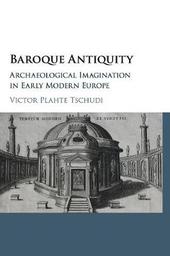
|
Baroque Antiquity: Archaeological Imagination in Early Modern Europe
Hardback
Main Details
| Title |
Baroque Antiquity: Archaeological Imagination in Early Modern Europe
|
| Authors and Contributors |
By (author) Victor Plahte Tschudi
|
| Physical Properties |
| Format:Hardback | | Pages:320 | | Dimensions(mm): Height 262,Width 188 |
|
| Category/Genre | Archaeology by period and region |
|---|
| ISBN/Barcode |
9781107149861
|
| Classifications | Dewey:940 |
|---|
| Audience | | Professional & Vocational | | Tertiary Education (US: College) | |
|---|
| Illustrations |
8 Plates, color; 100 Halftones, black and white
|
|
Publishing Details |
| Publisher |
Cambridge University Press
|
| Imprint |
Cambridge University Press
|
| Publication Date |
12 September 2016 |
| Publication Country |
United Kingdom
|
Description
Why were seventeenth-century antiquarians so spectacularly wrong? Even if they knew what ancient monuments looked like, they deliberately distorted the representation of them in print. Deciphering the printed reconstructions of Giacomo Lauro and Athanasius Kircher, this pioneering study uncovers an antiquity born with print culture itself and from the need to accommodate competitive publishers, ambitious patrons and powerful popes. By analysing the elements of fantasy in Lauro and Kircher's archaeological visions, new levels of meaning appear. Instead of being testimonies of failed archaeology, they emerge as complex architectural messages responding to moral, political, and religious issues of the day. This book combines several histories - print, archaeology, and architecture - in the attempt to identify early modern strategies of recovering lost Rome. Many books have been written on antiquity in the Renaissance, but this book defines an antiquity that is particularly Baroque.
Author Biography
Victor Plahte Tschudi is a Professor in Architectural History at the Oslo School of Architecture and Design. He writes on the interpretation of Roman monuments in texts and images from the Renaissance to the present.
Reviews'Tschudi has examined forty copies of Lauro for this extremely well-researched book. He has immersed himself not only in the Renaissance antiquarian texts, but also in the literature on the highly competitive Roman print industry. There are remarkable insights at every turn. ... This thoughtful, elegantly written book has demonstrated that in our post-truth world scholarship should make room for Lauro too.' Joseph Connors, Renaissance Quarterly '... Rivets the reader's attention while covering a broad swathe of ideas and history (from antiquity to the baroque), bristling with ideas and archaeological imaginings which are rich, varied, and at times pleasingly complex; a baroque complexity befitting the author's themes and dazzling critiques as well as straightforward accounts. Tschudi bestows on the reader something deeply considered, and-in the sense that he meditates on how in early modern Rome the past came to be understood in light of the baroque present (mostly seventeenth century) and how it might be retrieved-profound ... I heartily advise the reader, whom I suppose to be interested in art history of the early modern period in Rome, to get this book and enjoy Tschudi's investigations and his art historical perambulations ...' Vernon Hyde Minor, Journal of Jesuit Studies '... addresses, with coruscating wit, a more challenging aspect of Lauro's handiwork: the fact that so many of his reconstructions of ancient monuments fly in the face of archaeological accuracy, not just in the details, but entirely ... Tschudi introduces readers to another seventeenth-century rogue, albeit one with an imagination as epic as Piranesi's: Father Athanasius Kircher, the German refugee who spent most of his life at the Jesuit Roman College in Rome and, like Giovanni Alto before him, served as a point of reference for German visitors to the Eternal City. Kircher's reconstructions of ancient Roman monuments are sometimes as extravagantly fictitious as any caprice of Lauro's Antiquae Urbis Splendor, and sometimes, again like Lauro's, as accurate as modern scholarship could make them. The printmaker and the Jesuit savant departed from archaeological accuracy not out of ignorance, but by deliberate choice, and thereby hangs Tschudi's fascinating story.' Ingrid D. Rowland, New York Review of Books 'One of the many virtues of Victor Plahte Tschudi's book is that it takes Kircher's efforts in Christian archaeology seriously, and integrates them into a larger story: the story of what the author calls 'baroque archaeology', which flourished in Rome from around 1580 to 1680.' Anthony Grafton, London Review of Books 'Tschudi's writing is nimble and engaging, worthy of his eccentric and delightful subject(...)Tschudi's book represents a key new contribution to the literature, offering valuable insights into the complex and changing-not to say baroque-relationship between antiquarians and antiquity.' David Karmon, Future Anterior: Journal of Historic Preservation, History, Theory, and Criticism 'One of the many virtues of Victor Plahte Tschudi's book is that it takes Kircher's efforts in Christian archaeology seriously, and integrates them into a larger story: the story of what the author calls 'baroque archaeology', which flourished in Rome from around 1580 to 1680.' Anthony Grafton, London Review of Books
|